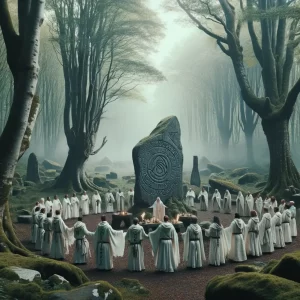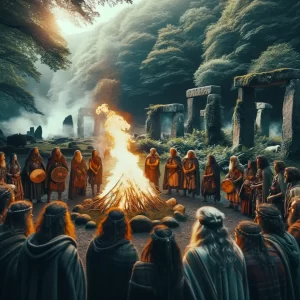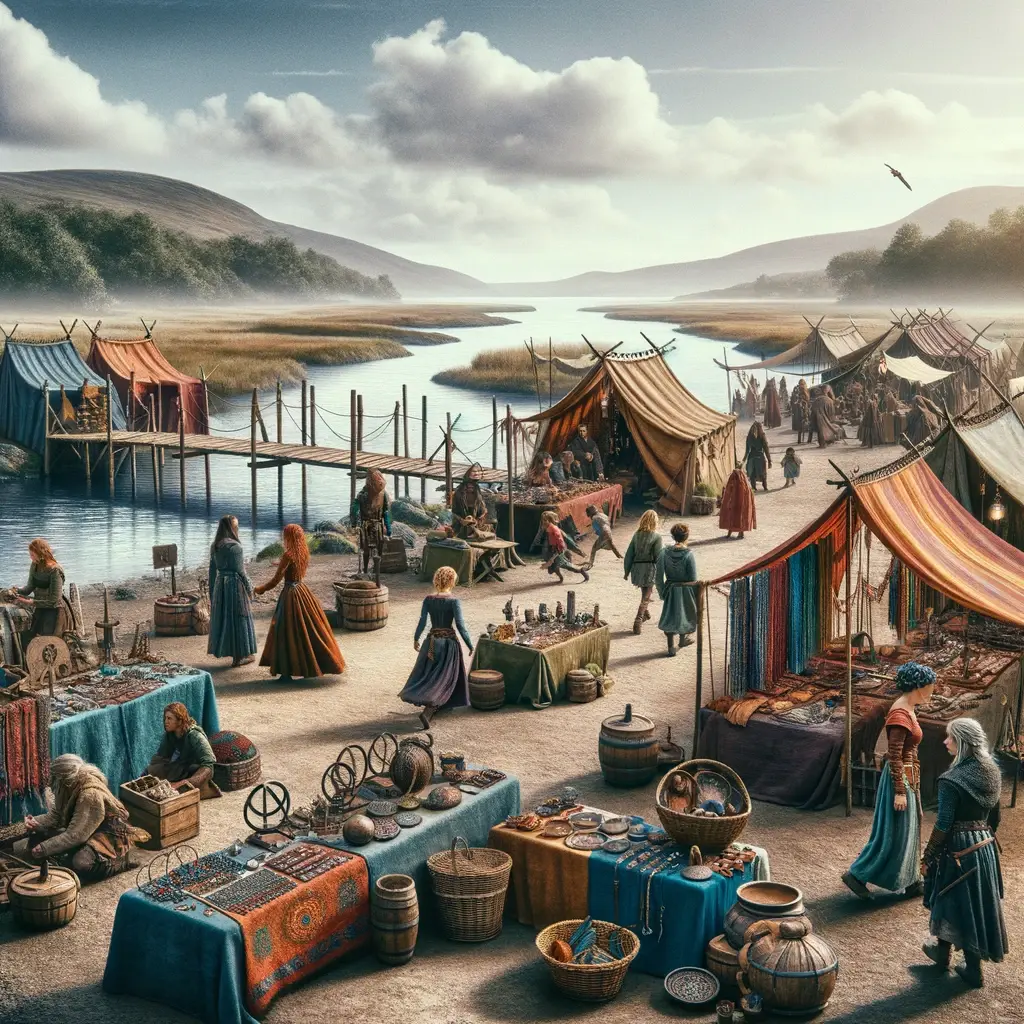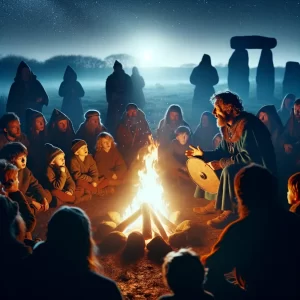The Celts were a group of Indo-European peoples who lived in Europe and Anatolia. They were identified by their use of Celtic languages and cultural similarities. The Celts were known for their metalworking skills, which allowed them to build extensive trade networks with ancient Greece and Rome. They were also skilled warriors and were feared by many of their enemies.
The Celtic culture started to emerge in central Europe, and it is believed that the Celts migrated to different parts of Europe over time. They settled in areas such as Ireland, Britain, Spain, and Turkey. The Celts were a collection of tribes that shared a similar language, religious beliefs, traditions, and culture.
The Celts were the largest group in ancient Europe, with territory stretching from Spain to the Black Sea. They had a significant impact on the development of European culture and society. Today, the legacy of the Celts can be seen in many aspects of modern life, including art, music, literature, and language.

Historical Overview
The Celts were a group of tribes that originated in central Europe and shared similar language, religious beliefs, traditions, and Celtic culture. The Celtic culture is believed to have started around 1200 BCE during the Bronze Age. The Celts were known for their skilled metalwork, especially in gold and bronze.
During the Iron Age, the Celts expanded their territory and migrated to different parts of Europe, including Gaul (modern-day France), the Balkans, and the British Isles. The Celts established settlements in these regions and formed tribes, each with its own chieftain.
In 390 BCE, the Celts invaded Rome and sacked the city. This event marked the beginning of the Roman-Celtic Wars. Julius Caesar later conquered Gaul in 58 BCE and brought the Celts under Roman rule. The Celts continued to resist Roman conquest, and the Gallic Wars lasted until 51 BCE.
The Celts in Britain and Ireland were not conquered by the Romans and maintained their independence. The Irish Celts established a strong warrior culture and were known for their fierce resistance to invasion. The Welsh Celts also maintained their independence and formed their own kingdoms.
The Celts left a lasting legacy in Europe, especially in their language and Celtic culture. The La Tène culture, named after a Celtic settlement in Switzerland, was a distinct artistic and cultural style that spread throughout Europe during the Iron Age. The Celts also had a strong sense of identity and were proud of their heritage as Indo-European people.
Today, the Celtic identity is still celebrated in regions such as Brittany, Cornwall, and Galicia. Archaeological evidence and historical accounts from Greek and Roman historians provide valuable insights into the history of the Celts.
Religion and Mythology
The ancient Celts had a rich and complex religious and mythological tradition that was closely tied to their social and cultural practices. Their religion was polytheistic, meaning they believed in many gods and goddesses, each associated with different aspects of nature and human life.
Celtic Mythology Symbols
One of the most recognizable symbols of Celtic mythology is the triquetra, also known as the Trinity Knot. This knot is made up of three interlocking loops and is often associated with the Christian Holy Trinity, but it has roots in Celtic mythology as well. The triquetra is thought to represent the interconnectedness of the three realms: the earth, the sea, and the sky. Celtic knots are an important part of Celtic symbolism.
Another important symbol in Celtic mythology is the spiral. This symbol can be found in many ancient Celtic artifacts and is believed to represent the cyclical nature of life and the universe. The spiral can also symbolize growth and transformation.
Celtic Mythological Creatures
Celtic mythology is full of fantastical creatures, many of which have become popular in modern fantasy literature and media. One of the most famous of these creatures is the leprechaun, a mischievous fairy who is said to guard pots of gold at the end of rainbows.
Another well-known creature from Celtic mythology is the banshee, a female spirit who is said to wail and scream when someone is about to die. The selkie is another mythical creature from Celtic folklore, a seal who can shed its skin and transform into a human.

Celtic Tree of Life
The Celtic Tree of Life is a powerful symbol in Celtic mythology, representing the interconnectedness of all living things. The tree is often depicted with branches reaching up to the sky and roots reaching down into the earth, symbolizing the connection between heaven, earth, and the underworld.
Each tree in the Celtic Tree of Life is associated with a different aspect of nature and human life, such as wisdom, strength, or creativity. The oak tree, for example, is associated with strength and endurance, while the willow tree is associated with healing and intuition.
Language and Celtic Culture
Celtic Languages
The Celtic languages are a branch of the Indo-European language family, spoken throughout much of Western Europe in Roman and pre-Roman times. The Celtic languages include Welsh, Gaelic, Breton, Cornish, and Manx. Although these languages are not widely spoken today, they have had a significant impact on the development of the English language.
Names from Celtic Mythology
Celtic mythology is a rich source of names that have been passed down through the ages. Many of these names are still in use today, such as Danu, the mother goddess of the Tuatha Dé Danann, and Anu, the goddess of fertility, love, and abundance. Other names, such as Kelt and Galli, were used by the ancient Greeks and Romans to refer to the Celts.
Celtic Traditions
The Celts had a rich and varied culture, with many traditions that have been passed down through the ages. One of the most well-known traditions is that of the druids, who were the spiritual leaders of the Celtic people. The druids were responsible for performing religious ceremonies, and were also the keepers of knowledge and wisdom.
Another important tradition in Celtic culture was the use of symbols and artwork. The Celts were known for their intricate knotwork designs, which were used to decorate everything from clothing to weapons. These designs were often symbolic, representing concepts such as the interconnectedness of all things.

Society and Lifestyle
Clothing and Jewelry
Celtic clothing was made of wool, which was popular because of its warmth and durability. Women wore long dresses and men wore tunics and trousers. The Celts were skilled metalworkers and made jewelry from gold, silver, and bronze. The jewelry was often decorated with intricate designs and symbols.
Warrior Celtic Culture
The Celts were known for their warrior culture and were skilled in battle. They fought with weapons such as swords, spears, and shields. Warriors were highly respected in Celtic society and were often rewarded with land and wealth. The Celts also had a code of honor that emphasized bravery and loyalty.
Settlements and Forts
The Celts lived in settlements that were often fortified with walls and ditches. These settlements were typically made up of roundhouses, which were constructed of wood and thatch. The Celts also built forts, which were larger and more heavily fortified than settlements. These forts were used for defense and as a base for raids.
The Celts had a complex society with a strong emphasis on family and community. They were skilled metalworkers, producing intricate jewelry and weapons. The Celts were also known for their woolen clothing, which was warm and durable. The warrior culture was an important part of Celtic society, with warriors being highly respected and rewarded. Settlements and forts were an important part of Celtic life, providing protection and a sense of community.
Frequently Asked Questions
What is the history of the Celtic people?
The Celtic people were a diverse group of tribes that originated in central Europe around 1200 BCE. They spread across Europe, eventually settling in regions such as Ireland, Scotland, Wales, and Brittany. The Celts were known for their fierce warriors, skilled artisans, and rich mythology. They were eventually conquered by the Romans and later assimilated into other cultures.
Where did the Celts originate from?
The Celts originated from central Europe, specifically the area that is now Austria, Germany, and Switzerland. They were part of the larger Indo-European group of peoples that migrated across Europe during the Bronze Age.
Who are considered descendants of the Celts?
Many modern-day people in Ireland, Scotland, Wales, and Brittany consider themselves descendants of the Celts. However, DNA studies have shown that there is no clear genetic link between these modern populations and the ancient Celts.

What were some notable achievements of Celtic warriors?
Celtic warriors were known for their bravery and ferocity in battle. They were skilled with weapons such as swords, spears, and shields. Celtic warriors were also known for their distinctive blue war paint and long hair, which they believed gave them a fearsome appearance.
What is the cultural significance of the Celtic people?
The Celtic people have had a significant impact on European culture, particularly in the areas of art, literature, and mythology. Celtic art is known for its intricate knotwork and spirals, while Celtic mythology features a rich cast of gods and goddesses, heroes and villains, and magical creatures.
How did the Celts influence modern society?
The influence of the Celts can be seen in modern-day celebrations such as St. Patrick’s Day, which originated as a religious holiday in Ireland but has since become a global celebration of Irish culture. Celtic music, dance, and literature have also had a lasting impact on modern culture, inspiring artists and writers around the world.
What is Celtic culture known for?
Celtic culture is renowned for its rich history, distinctive art, and music. Originating in Central Europe, the Celts spread across much of Western Europe, including present-day Ireland, Scotland, Wales, and parts of Spain and France. Their art is characterized by intricate patterns and designs, often seen in their metalwork, jewelry, and illuminated manuscripts. The Celts were also known for their warrior societies, druidic traditions, and storytelling. Celtic music, with its unique instruments like the harp and bagpipes, has had a significant influence on the world music stage.
Is Ireland a Celtic culture?
Yes, Ireland is considered one of the six “Celtic nations,” along with Scotland, Wales, Cornwall, Isle of Man, and Brittany. These regions are where the Celtic languages and cultural traits have survived most robustly. Ireland, in particular, has a rich Celtic heritage that is evident in its language, music, folklore, and traditions. The Irish language (Gaeilge) is a Celtic language, and many of the country’s festivals and legends have Celtic origins.
What is Celtic culture today?
Today, Celtic culture is celebrated and preserved mainly through music, dance, art, and festivals. In regions like Ireland, Scotland, and Wales, traditional Celtic music and dance are still popular and often performed at cultural events and gatherings. Many modern artists draw inspiration from Celtic patterns and symbols in their work. Festivals like Samhain, which inspired Halloween, and Beltane are celebrated in various forms across the Celtic nations. Moreover, there’s a resurgence in learning Celtic languages and traditions in an effort to keep the culture alive and thriving.
What were the Celtic culture and beliefs?
The Celts had a polytheistic belief system, worshiping a pantheon of gods and goddesses, each associated with different aspects of life and nature. Druids, the religious leaders of the Celts, played a central role in their spiritual practices, conducting ceremonies, rituals, and acting as mediators between the gods and the people. The Celts believed in an afterlife and held that the soul was immortal, transitioning to another world after death. Nature played a significant role in their beliefs, with many sacred sites, like groves and springs, used for worship. They also had a rich tradition of storytelling, where myths, legends, and tales were passed down orally through generations.
Check out this video below to learn more:


